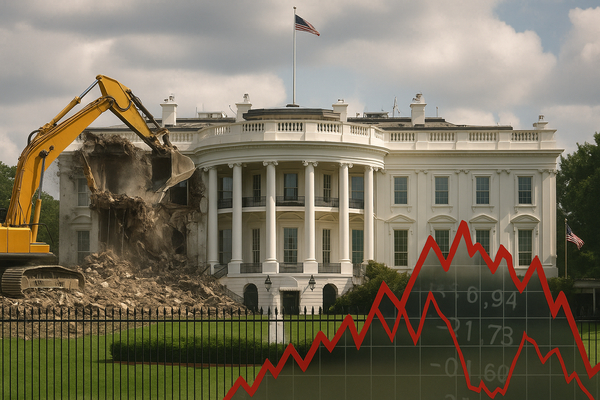
White House demolition is now literal and it is reshaping perceptions of U.S. governance. The razing of the East Wing, a fast-moving renovation plan and questions about process are driving short-term uncertainty. In the near term markets must price higher political risk and operational disruption in the federal government. Over the longer term the episode signals a steady erosion of institutional norms that could weigh on investor confidence across the United States, Europe and emerging markets. Global trade ties are on watch as the president leaves for an Asia trip while new sanctions on Russia widen geopolitical risk.
White House makeover and governance uncertainty
Subtitle: How a visible renovation turned into a test of transparency and institutional checks
The demolition of the White House East Wing for a proposed ballroom has become a vivid display of policy style. The president had said the ballroom would not touch the historic building. Yet demolition crews began tearing down part of the East Wing this week. The contrast between prior assurances and the speed of action has prompted calls for a halt and demands for a formal review.
The plan now faces a three month review by the National Capital Planning Commission. That body is chaired by a White House staffer, Will Scharf. The dual role raises questions about separation between policymaking and oversight. Public comment will be accepted as part of the review, but demolition is already under way.
Markets care about this for more than symbolism. Institutional trust and predictable processes support steady policy formulation. Faster unilateral action reduces transparency. That tends to increase measured political risk for assets that rely on steady rule making. For real assets such as federal property, construction contracts and suppliers the immediate impact is direct. For financial markets the effect is more diffuse and psychological. Investors price the chances of abrupt regulatory changes differently when checks appear weakened.
Fiscal strain from the government shutdown
Subtitle: Pay interruptions and missing data that amplify economic uncertainty
The U.S. government remains shut down. Tens of thousands of civil servants will not receive a full paycheck this week. The interruption is the first of its kind since the shutdown began. Beyond household hardship, payroll gaps have ripple effects for consumption and regional demand where federal workers are concentrated.
Operational impacts are also relevant for markets. The shutdown disrupts the release of some economic data. When official statistics are delayed or scaled back, traders and analysts face wider confidence intervals on growth and inflation readings. That greater uncertainty can push market participants toward safe haven assets and shorten time horizons for risk taking.
For companies whose revenue depends on federal contracting or regulatory approvals the shutdown slows revenue recognition and project starts. Sectors with heavy government exposure may see higher short-term volatility. Meanwhile, fiscal follow through and any legislative responses will be watched closely for their effects on deficits and Treasury issuance plans.
Sanctions on Russia and the Asia trip
Subtitle: Geopolitical moves that could shift commodity and trade dynamics
The administration imposed new sanctions on Russia after Moscow declined to pursue a negotiated settlement in Ukraine. The president also declined a planned meeting with Vladimir Putin and will instead travel to Asia with stops in Malaysia, Japan and the APEC summit in South Korea. A meeting with Chinese President Xi Jinping is expected.
Sanctions widen geopolitical risk and can influence energy and commodity markets, especially if they affect Russian exports. They also prompt buyers to seek alternative suppliers. For equities, defense related names and firms exposed to commodity price swings may see sensitivity to fresh measures. More broadly, emerging markets can react to shifts in risk appetite and capital flows that follow sanctioning regimes.
The Asia trip adds another layer. Any progress or setbacks in U.S.-China engagement will matter for trade, investment and supply chains. Markets will track announcements and tone closely. Even without formal deals, meetings between leaders often move sentiment around trade policy and technology cooperation.
Political polarization, legal battles and market psychology
Subtitle: Court dates, polling and health care timelines that feed investor risk premiums
Political division is rising. A Reuters/Ipsos survey shows growing public worry about domestic political conflict. Legal and electoral developments are front and center. A high profile court appearance by a state attorney general is scheduled on the same day that many federal workers will miss full paychecks. The Voting Rights Act faces intense debate at the Supreme Court, and Democrats are focusing on affordability issues ahead of a health care enrollment window.
Health policy timelines matter for sizable populations. The Affordable Care Act open enrollment starts November 1. About 24 million Americans obtain coverage through the program. Changes to pricing, subsidies or outreach can affect health insurers, hospitals and household budgets. Even when courts and policy makers act slowly, the mere uncertainty about future rules creates a risk premium for companies with heavy U.S. exposure.
Historical experience shows that sustained political conflict can raise market volatility and compress investment horizons. That effect is often uneven. Defensive sectors and safe haven assets tend to outperform in episodes of heightened political risk while cyclical sectors can lag. Regional outcomes vary. European markets watch spillover effects on trade and rules. Asian markets monitor U.S.-China signals closely because of global supply chain integration.
What to watch next: the president departs for Asia on October 24, the same day many civil servants will see interrupted pay. Sanctions implementation and any statements from the APEC meetings will be read for signals on energy and trade. The three month review process for the White House ballroom will test institutional controls and public scrutiny. Finally, the start of ACA open enrollment on November 1 will provide clarity on consumer health costs and insurer positioning. All of these items will feed market assessments of policy continuity, operational risk and geopolitical exposure in the weeks ahead.












